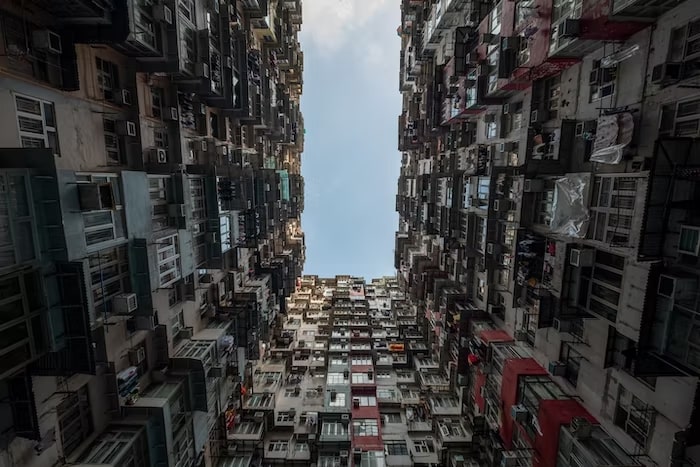Categories > Guides and Tips

Why is Hong Kong so overpopulated?
Locals and foreigners alike feel that Hong Kong can sometimes be suffocatingly crowded. But what exactly causes this overpopulation?
The answer is complex. Let’s dive right in and talk about why Hong Kong is so population-dense.
Why is Hong Kong overpopulated?
Hong Kong appears overpopulated because of a lack of land and livable space and an influx of immigrants and tourists. Both factors contribute to the apparent density of population in the region.
Hong Kong’s Lack of Livable Space

To say that Hong Kong is overpopulated can be a bit misleading. The special administrative region is population-dense not because it has exhausted all the living space but because of geographical and political constraints.
Geographically speaking, Hong Kong does not have many flat areas to build cities and residences. Hong Kong is dotted with mountains, forests, and nature reserves that are unsuitable for humans to build houses on.
Changing the landscape to fit human needs would come at the expense of the flora and fauna, government funds, or both.
Because of the terrain, only a small percentage of the total land in Hong Kong is used for residence and commerce, with most of these being concentrated on Hong Kong Island and Kowloon.
As such, other territories are mostly undeveloped or underdeveloped. There are also islands in Hong Kong that are uninhabited because of the terrain.
Since the people cannot build outwards without repercussions, Hong Kongers are squeezed into a small area, so they built upwards instead, resulting in the high-rise buildings you see in Hong Kong today.
The land-related political constraint comes with the government owning all of the developable lands and leasing them, usually for 50 years, to those it sees fit.
Hong Kong’s land leases are one of the few ways the government can make money to keep the region rich and maintain its business-friendly free-market capitalist economic policies.
Since lands are expensive, only the rich can buy them and build buildings… which they then rent out to Hong Kongers at an astronomical price. An ordinary Hong Konger cannot simply purchase land and build on it like how people in other countries do.
This lack of space cannot meet the people’s residential demand, leading to a long-running housing crisis that leaves many locals unhappy and even pushes some of them to leave Hong Kong for somewhere more comfortable.
Massive Inflow of Immigrants and Tourists

There is a system in Hong Kong called the “one-way permit scheme,” which allows 150 people to move from the mainland to Hong Kong each day.
This programme has been in place since the 1980s, allowing thousands upon thousands of mainlanders to settle in Hong Kong.
Because of this system, immigrating mainlanders are competing for resources with an already-overcrowded Hong Kong. One of Hong Kong’s lawmakers even likened the region to a “severely overcrowded ship” that will sink because it let in too many people.
A real estate developer even expects Hong Kong to attract rich mainlanders to buy luxury properties now that Shanghai’s lockdowns are lifted.
It’s not only the immigrants that Hong Kongers have to compete with for space. They also have to adjust to tourists coming from all over the globe.
For example, around 722,000 mainlanders entered Hong Kong in just four days for the Lunar New Year celebration. Hong Kong also recorded over 65 million international arrivals in 2018.
Although these numbers are hard to emulate now due to the pandemic restrictions in the special administrative region, they still indicate how many immigrants and tourists want to enter Hong Kong.
The Walled City of Kowloon – A Case Study
Perhaps the best example to use to illustrate Hong Kong’s population problem is the story of the Kowloon Walled City.
The Kowloon Walled City used to be a Chinese military fort north of Hong Kong but became an enclave when China leased the New Territories to Britain. When the Japanese occupied China during the war, Chinese residents began moving towards the area.
This large inflow of immigrants led to a housing crisis in Kowloon, so people, especially entrepreneurs seeking to capitalise on the increased demand, built buildings with no planning and no regulation.
After a fire, people rebuilt the city with brick and concrete. Since they could not build past the walls of Kowloon, the people started building upwards, resulting in multiple high-rise complexes that shadow each other.
From the 1940s to the 1950s, there were around 33,000 people living in the Walled City. The population peaked in the 1980s when the population grew to 50,000 people living in only 0.26 kilometres of living space.
Mass immigration and a lack of land combined created a claustrophobic city where thousands of people have to share and compete for resources, including living space.
The population density also exacerbated problems regarding health and crime.
Kowloon’s Walled City illustrates what is happening currently in Hong Kong, with the main difference being that the current issues are occurring over a larger area.
How is overcrowding affecting Hong Kongers?

Overcrowding in Hong Kong has led to numerous problems with the primary ones being a grave housing crisis due to a lack of affordable housing and worsening living conditions.
In Hong Kong, citizens cannot simply purchase land and construct their own houses. There are few to no houses to buy to begin with unless you include expensive vacation homes in the countryside.
The ordinary Hong Konger has to rent a place to live. However, not only do they have to compete with others also looking for a place to call home, but they also have to deal with the unreasonably high rent that most landlords charge.
| Monthly Rent | Price |
| One-bedroom apartment in the city | $20,000 |
| One-bedroom apartment outside of the city | $14,000 |
| Cage homes | ~$2,500 |
| Luxury pods / Capsule homes | ~$400 |
To deal with the demand for housing, some even began subdividing flats and suites into smaller apartments just to accommodate lower- to middle-income families and immigrants. However, these are unregulated and still charge exorbitant rent.
According to a survey, at least 20% of these tenants are overcharged for utilities that barely work.
Some Hong Kongers, especially those living below the poverty line, even rely on sleeping in “cage homes” where they live in small, windowless, dilapidated rooms where they share a toilet with other tenants.
Some even decided to rent “luxury pods” or capsule homes, where they have a total of 2.2 square metres to themselves, primarily for sleeping.
Unsurprisingly, Hong Kongers that are packed in such a small area have to deal with dismal living conditions. Extreme heat due to global warming becomes an immediate issue, especially during the warmer months.
According to a report by the Society for Community Organization, a nongovernment group focused on the housing crisis, Hong Kong’s poorly-designed structures and cramped living spaces could feel 5 to 6 degrees Celsius hotter than the outside.
All in all, Hong Kong’s overcrowding issue affects the indigent and underprivileged the most as they have to deal with all of these issues in addition to their daily struggle to subsist.
What is the Hong Kong government’s response to overcrowding?

The Hong Kong government pledges to boost public housing and fix overall land and housing supply issues to address the overcrowding and housing crises.
As of the moment, the average waiting time for a public housing apartment in Hong Kong is 6.1 years. A total of 147,500 applications swamp Hong Kong’s Housing Authority, causing major backlogs and supply issues.
However, the Chief Executive proposed an advanced allocation scheme and other projects to hasten the rollout and make the projects available as soon as possible.
The government of Hong Kong is also reportedly considering expanding its territory and creating a vast man-made island that could house over a million people.
In 2018, the chief executive of Hong Kong showcased a plan to create a 4,200-acre island near Lantau Island. The project is estimated to cost around 500 billion Hong Kong Dollars and is expected to house 1.1 million people displaced by the housing crisis.
Although such plans are well-intentioned, the project would face numerous legal, ecological, and technical issues. The government would also have to deal with the public backlash and the critics’ concerns.
There are some that oppose the project as it could gravely affect marine wildlife. Many also go against the project because it might endanger those that will live there due to erosion and the worsening effects of climate change.





